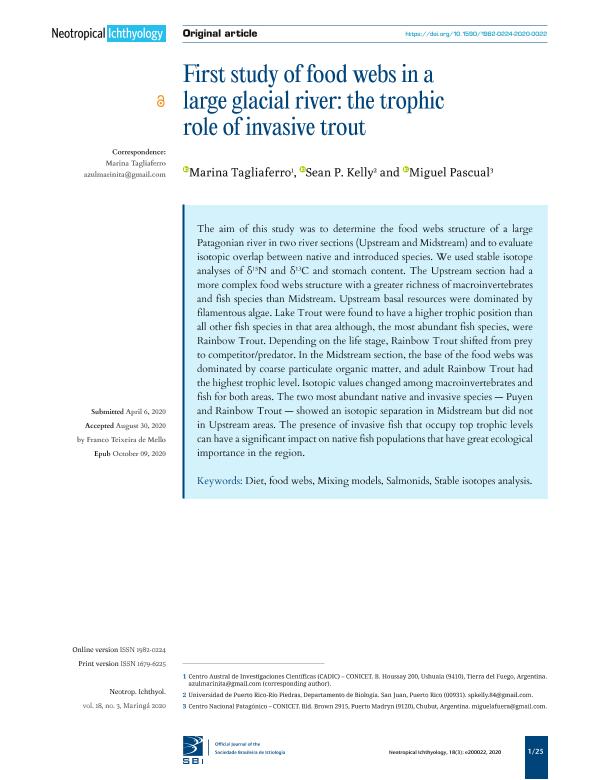Mostrar el registro sencillo del ítem
dc.contributor.author
Tagliaferro, Marina Beatriz

dc.contributor.author
Kelly, Sean P.
dc.contributor.author
Pascual, Miguel Alberto

dc.date.available
2021-08-19T13:11:59Z
dc.date.issued
2020-07
dc.identifier.citation
Tagliaferro, Marina Beatriz; Kelly, Sean P.; Pascual, Miguel Alberto; First study of food webs in a large glacial river: the trophic role of invasive trout; Sociedade Brasileira de Ictiologia; Neotropical Ichthyology; 18; 3; 7-2020; 1-25
dc.identifier.issn
1679-6225
dc.identifier.uri
http://hdl.handle.net/11336/138511
dc.description.abstract
El objetivo de este estudio fue determinar la estructura trófica de un gran río de la Patagonia en dos secciones (río arriba y medio) y evaluar la superposición isotópica entre especies nativas e introducidas. Utilizamos análisis de isótopos estables δ15N y δ13C y contenido estomacal. La sección río arriba tuvo una estructura de trama trófica más compleja, con mayor riqueza de macroinvertebrados y peces respecto de la sección media. Los recursos basales dominantes río arriba fueron las algas filamentosas. En esta área, la trucha de lago tuvo la posición trófica más alta entre los peces, aunque, las especies de peces más abundantes fueron las truchas arcoiris. Dependiendo del estadio, la trucha arcoiris cambió su rol de presa a competidor/depredador. En la sección media del río, la base de la trama trófica estuvo dominada por materia orgánica particulada gruesa y la trucha arcoíris adulta fue el depredador tope. Los valores isotópicos variaron entre zonas para invertebrados y peces. Las dos especies nativas e invasoras más abundantes, Puyen y trucha arcoiris, mostraron una separación isotópica en la sección media, pero no en secciones de río arriba. La presencia de peces invasores que ocupan una posición tope en los niveles tróficos puede tener un impacto significativo sobre las poblaciones de peces nativos de gran importancia ecológica en la región
dc.description.abstract
The aim of this study was to determine the food webs structure of a large Patagonian river in two river sections (Upstream and Midstream) and to evaluate isotopic overlap between native and introduced species. We used stable isotope analyses of δ15N and δ13C and stomach content. The Upstream section had a more complex food webs structure with a greater richness of macroinvertebrates and fish species than Midstream. Upstream basal resources were dominated by filamentous algae. Lake Trout were found to have a higher trophic position than all other fish species in that area although, the most abundant fish species, were Rainbow Trout. Depending on the life stage, Rainbow Trout shifted from prey to competitor/predator. In the Midstream section, the base of the food webs was dominated by coarse particulate organic matter, and adult Rainbow Trout had the highest trophic level. Isotopic values changed among macroinvertebrates and fish for both areas. The two most abundant native and invasive species — Puyen and Rainbow Trout — showed an isotopic separation in Midstream but did not in Upstream areas. The presence of invasive fish that occupy top trophic levels can have a significant impact on native fish populations that have great ecological importance in the region.
dc.format
application/pdf
dc.language.iso
eng
dc.publisher
Sociedade Brasileira de Ictiologia

dc.rights
info:eu-repo/semantics/openAccess
dc.rights.uri
https://creativecommons.org/licenses/by-nc-sa/2.5/ar/
dc.subject
ANÁLISIS DE ISÓTOPOS ESTABLES
dc.subject
DIETA
dc.subject
MODELOS DE MEZCLA
dc.subject
SALMÓNIDOS
dc.subject
TRAMA TRÓFICA
dc.subject.classification
Ecología

dc.subject.classification
Ciencias Biológicas

dc.subject.classification
CIENCIAS NATURALES Y EXACTAS

dc.title
First study of food webs in a large glacial river: the trophic role of invasive trout
dc.type
info:eu-repo/semantics/article
dc.type
info:ar-repo/semantics/artículo
dc.type
info:eu-repo/semantics/publishedVersion
dc.date.updated
2021-07-30T18:02:34Z
dc.identifier.eissn
1982-0224
dc.journal.volume
18
dc.journal.number
3
dc.journal.pagination
1-25
dc.journal.pais
Brasil

dc.journal.ciudad
Puerto Alegre
dc.conicet.avisoEditorial
Since 2015, Neotropical Ichthyology publishes under a Creative Common BY license (Attribution). Articles accepted for publication become property of the journal.
dc.description.fil
Fil: Tagliaferro, Marina Beatriz. Consejo Nacional de Investigaciones Científicas y Técnicas. Centro Austral de Investigaciones Científicas; Argentina
dc.description.fil
Fil: Kelly, Sean P.. Universidad de Puerto Rico; Puerto Rico
dc.description.fil
Fil: Pascual, Miguel Alberto. Consejo Nacional de Investigaciones Científicas y Técnicas. Centro Científico Tecnológico Conicet - Centro Nacional Patagónico. Instituto Patagónico para el Estudio de los Ecosistemas Continentales; Argentina
dc.journal.title
Neotropical Ichthyology

dc.relation.alternativeid
info:eu-repo/semantics/altIdentifier/doi/https://doi.org/10.1590/1982-0224-2020-0022
dc.relation.alternativeid
info:eu-repo/semantics/altIdentifier/url/https://www.scielo.br/j/ni/a/v8cb6NGybdqxfjcyWBb9zht/?lang=en
Archivos asociados
